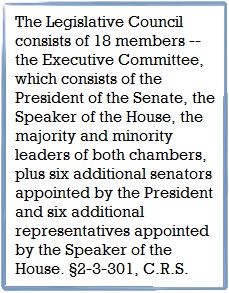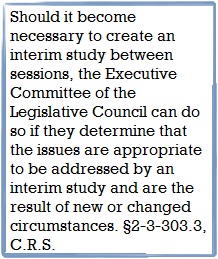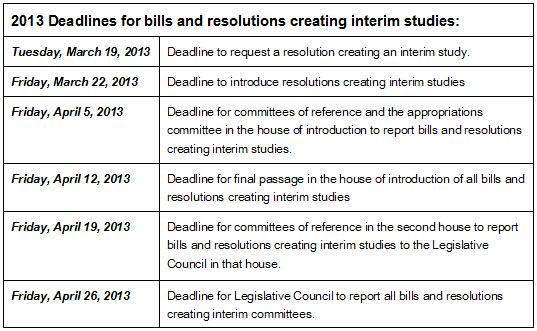by Patti Dahlberg and Julie Pelegrin
Do you ever feel like things during the legislative session are just going too fast and that certain bills and topics need much more in-depth study time than they can get during the legislative session? Well, there’s an “app” for that – so to speak. It’s called a legislative interim study committee or an “interim committee”. When a legislator has a specific topic that he or she feels deserves time for in-depth study and testimony from a variety of experts in the field, the legislator may introduce a bill or joint resolution to create an interim committee.
The General Assembly creates interim committees to provide a forum for the in-depth  study of specific issues during the months when the legislature is not in session. The General Assembly may create an interim committee either by bill or joint resolution. Each bill or joint resolution that creates an interim committee must be assigned to the Legislative Council, which sits as a committee of reference to hear this legislation. Each year, the General Assembly appropriates a certain amount of money to fund a limited number of interim committees. In most years, there is legislation to create more committees than the appropriation will fund. The Legislative Council reviews all of the legislation and selects those interim committees that will receive funding for the coming interim and postpones indefinitely the legislation for those committees that are not selected. See the table at the end of the article for the 2013 deadline dates for considering interim study committee bills and joint resolutions.
study of specific issues during the months when the legislature is not in session. The General Assembly may create an interim committee either by bill or joint resolution. Each bill or joint resolution that creates an interim committee must be assigned to the Legislative Council, which sits as a committee of reference to hear this legislation. Each year, the General Assembly appropriates a certain amount of money to fund a limited number of interim committees. In most years, there is legislation to create more committees than the appropriation will fund. The Legislative Council reviews all of the legislation and selects those interim committees that will receive funding for the coming interim and postpones indefinitely the legislation for those committees that are not selected. See the table at the end of the article for the 2013 deadline dates for considering interim study committee bills and joint resolutions.
The nuts and bolts of creating interim study committees
A bill or joint resolution that creates an interim study committee should specify the purpose of or charge to the committee, the specific issues the committee will study, any agencies that will provide staff support for the committee, and the committee’s membership — including the appointing authority for the members.
Unless otherwise specified in statute, in rule, or in the bill or joint resolution that creates the committee, the majority and minority membership of the interim study committee is proportional to the majority and minority party membership of the Senate and House of Representatives. Also, the President of the Senate or the Speaker of the House will appoint the chair and vice-chair, depending on the house of origin of the bill or joint resolution that creates the committee.
Some interim committees include persons other than legislators in their membership to provide the legislators with a wider range of experience in the specific topics that the interim committee is studying. In other cases, the chair and vice-chair of an interim committee may be authorized to appoint non-legislators to a task force that will work with and provide advice to the interim committee. In either case, the non-legislative members of the interim committee or task force cannot participate in a committee vote to approve  legislation.
legislation.
The number of committee meetings is usually limited to six, but the bill or joint resolution that creates the interim study committee may specify a different number of meetings. All travel expenses are subject to the Executive Committee’s approval before any travel occurs.
Activities of interim study committees
Once it’s created and the members are appointed, an interim study committee usually starts meeting in late July or early August. The chair and the vice chair work with the legislative council staff to set the meeting agendas and identify individuals or groups that they invite to present information to the committee concerning the issues that the committee has been created to study. Interim study committees are open to the public and, like all committee meetings held by the Colorado General Assembly, persons can listen to the meetings online. The committee chair may invite members of the public who attend the meetings to testify before the committee concerning the issues the committee is studying.
In addition to listening to committee meetings online, members of the public will find links to committee schedules, agendas, and meeting summaries on the committees portion of the General Assembly web site. The posted agendas include reports, presentations, and other items that the interim study committee will hear and discuss. Most interim committees meet in the State Capitol building, but an interim committee may travel to other cities and towns so long as travel is within the limitations of the committee’s budget and the Executive Committee approves the travel expenses.
After studying the issues, legislators who are serving on the interim study committee may request bills to address the issues. The Office of Legislative Legal Services will work with the committee to prepare and present bill drafts. The committee will post the proposed bills on the committee website when it considers the bills. The committee may recommend up to eight bills to the Legislative Council for approval as interim committee bills.
Approval of interim committee bills
Joint Rule 24(b)(1)(D) requires the Legislative Council to meet to approve interim committee bills no later than October 15 in even-numbered years and no later than November 15 in odd-numbered years. A bill that an interim study committee recommends for approval must have a prime sponsor before the Legislative Council will consider it. Usually interim study committee bills are sponsored by a member of the committee, but this is not required; legislators who are not committee members can sponsor committee bills. A bill that the Legislative Council approves does not count against a legislator’s five-bill limit. A legislator may choose to introduce a bill that is submitted to the Legislative Council but not approved. In that case, the bill will count against the legislator’s 5-bill limit.
What if an interim committee isn’t approved?
Legislators do not need a bill or a joint resolution to be able to study an issue in depth; they can bring interested parties or “stakeholders” together during the interim to discuss issues without creating an interim study committee. Legislators can reserve committee rooms in the Capitol to meet with stakeholders, discuss issues, and develop legislation for the upcoming session. Legislators can also request that a drafter attend a meeting at which they plan to discuss potential legislation. But, the legislators cannot claim a per diem for these meetings, and if a legislator introduces a bill that arises from these meetings, the bill will count against the legislator’s 5-bill limit.
